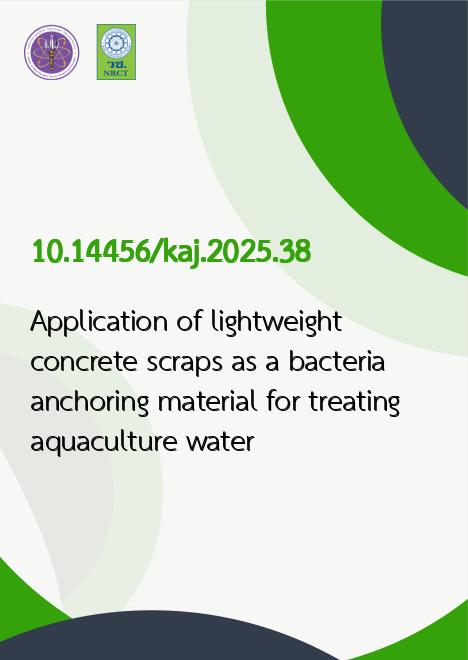
|
Application of lightweight concrete scraps as a bacteria anchoring material for treating aquaculture water |
|---|---|
| รหัสดีโอไอ | |
| Creator | Siripong Wongphonprateep |
| Title | Application of lightweight concrete scraps as a bacteria anchoring material for treating aquaculture water |
| Contributor | Phongpiram Rittikan, Warisa Tanmanee, Chayada Wongphonprateep |
| Publisher | Faculty of Agriculture |
| Publication Year | 2568 |
| Journal Title | Khon Kaen Agriculture Journal |
| Journal Vol. | 53 |
| Journal No. | 3 |
| Page no. | 516-529 |
| Keyword | lightweight concrete scraps, water treatment bacteria, Bacillus subtilis, water quality, biofilter media |
| URL Website | https://li01.tci-thaijo.org/index.php/agkasetkaj |
| Website title | Khon Kaen Agriculture Journal |
| ISSN | 3027-6497 (Online) |
| Abstract | An important factor in water quality for aquaculture is the presence of nitrogen compounds such as ammonia and nitrite originating from leftover feed and the debris of dead organisms in the pond. Anchoring materials for water treatment bacteria such as corals or volcanic rocks are commonly used. However, these materials are currently expensive and need to be imported. Utilization of an alternative low-cost bacterial anchoring material (lightweight concrete scraps: LCS) in combination with inoculation of Bacillus subtilis for water treatment was researched. This research involved the following steps: (1) analyzed the surface of LCS through surface imaging, (2) determined the percentage of dissolved dust, (3) monitored changes in water quality, and (4) measured the bacterial habitation on LCS. The results showed that LCS which were divided into three size categories: 25-30 mm (S), 35-40 mm (M), and 41-45 mm (L) (1), had a porous structure with pore size of approximately 200 micrometers. These pores occupied around 5% of LCS's total surface area. (2) When soaked in water, the LCS exhibited slight solubility with dissolved dust around 910% of its dry weight. (3) The study found that the alkaline, total soluble solid, and pH increased as LCS submerge times increased (P < 0.05). However, these parameters are still in acceptable limits for aquaculture. (4) Additionally, the use of 3540 mm LCS resulted in a significantly higher bacterial count compared to the other experimental sets (P < 0.05). The LCS slightly reduced levels of ammonia and nitrite in the water. However, LCS (regardless of size) was not significantly different in term of water quality parameters compared to other experimental sets (P > 0.05). These properties demonstrate that LCS can serve as a substitute material for lava rock in aquaculture biofiltration systems. |